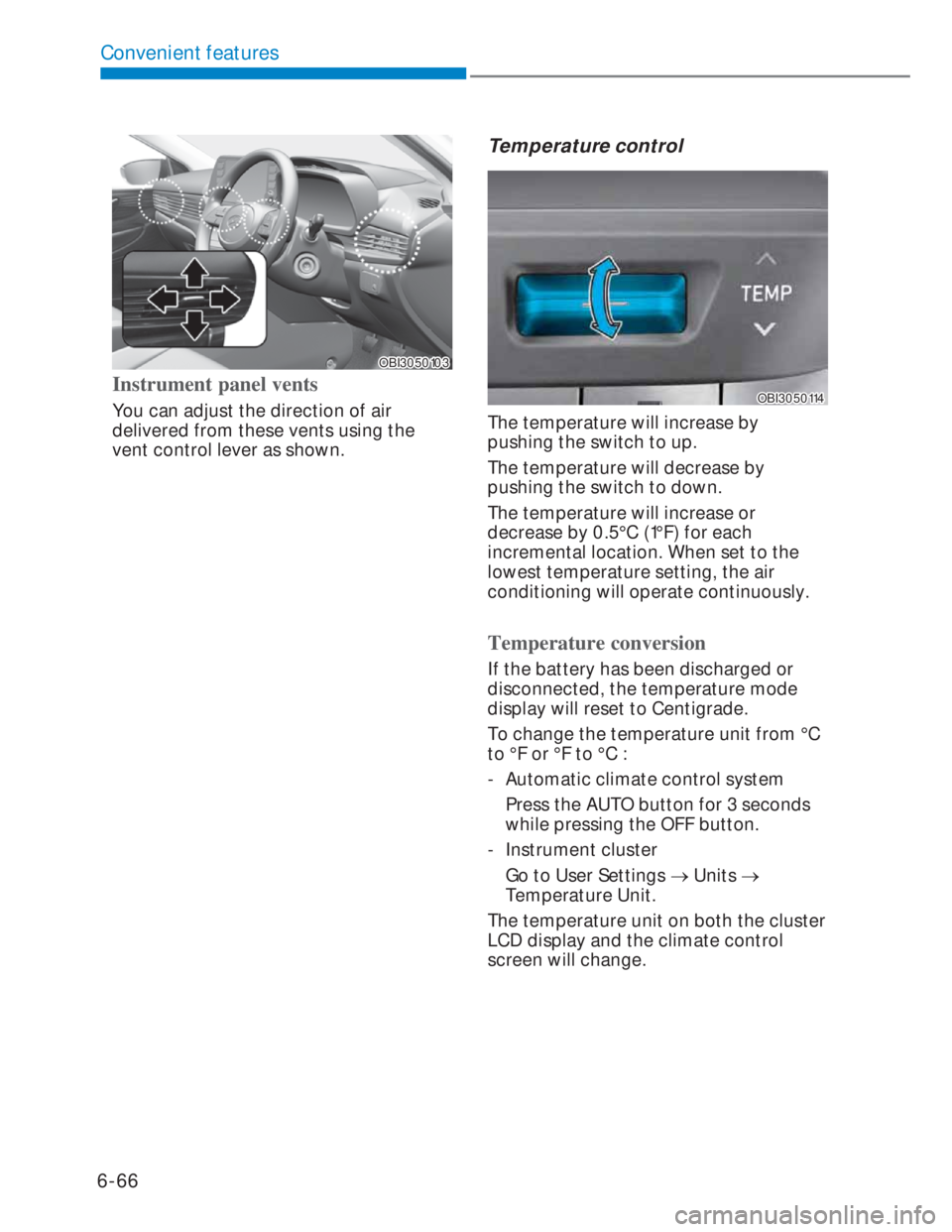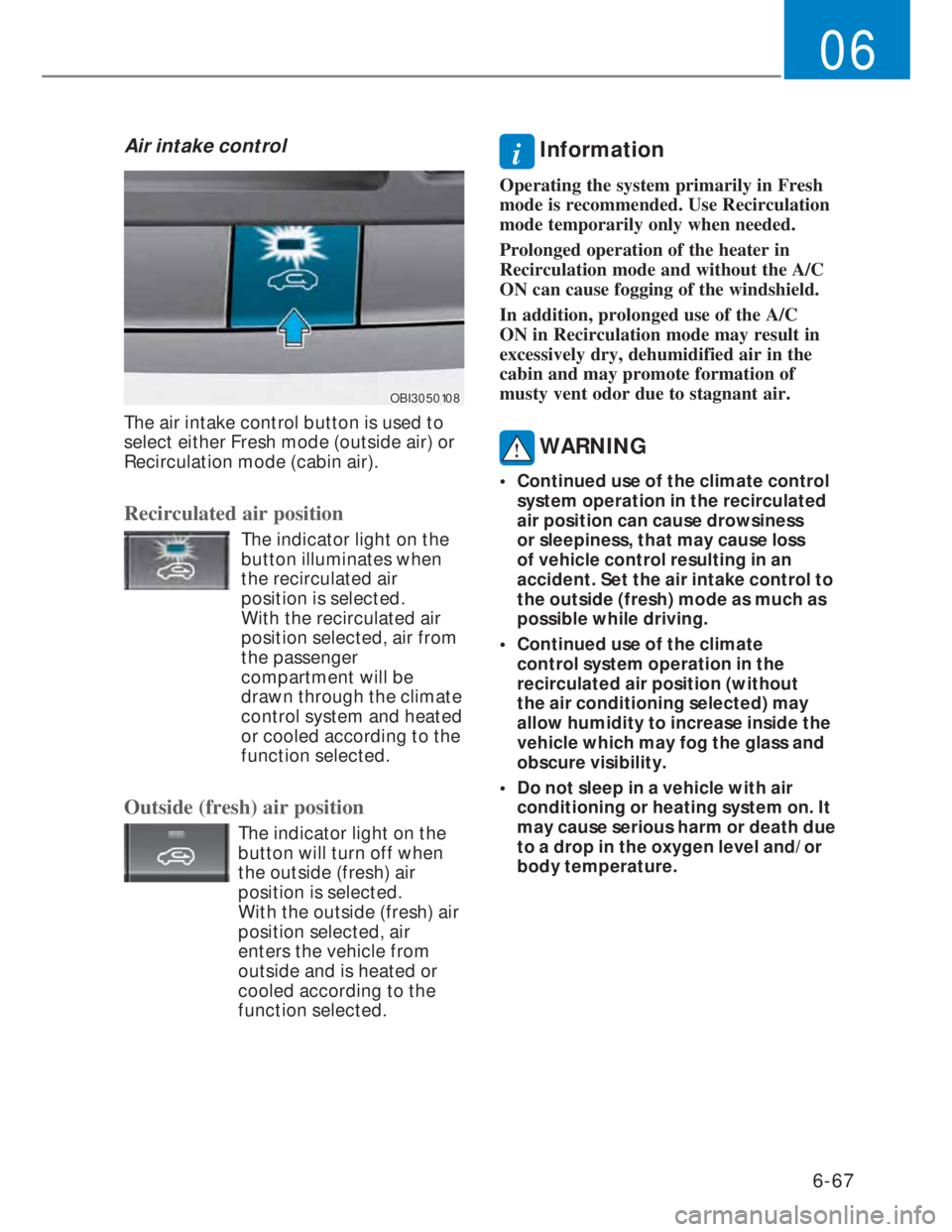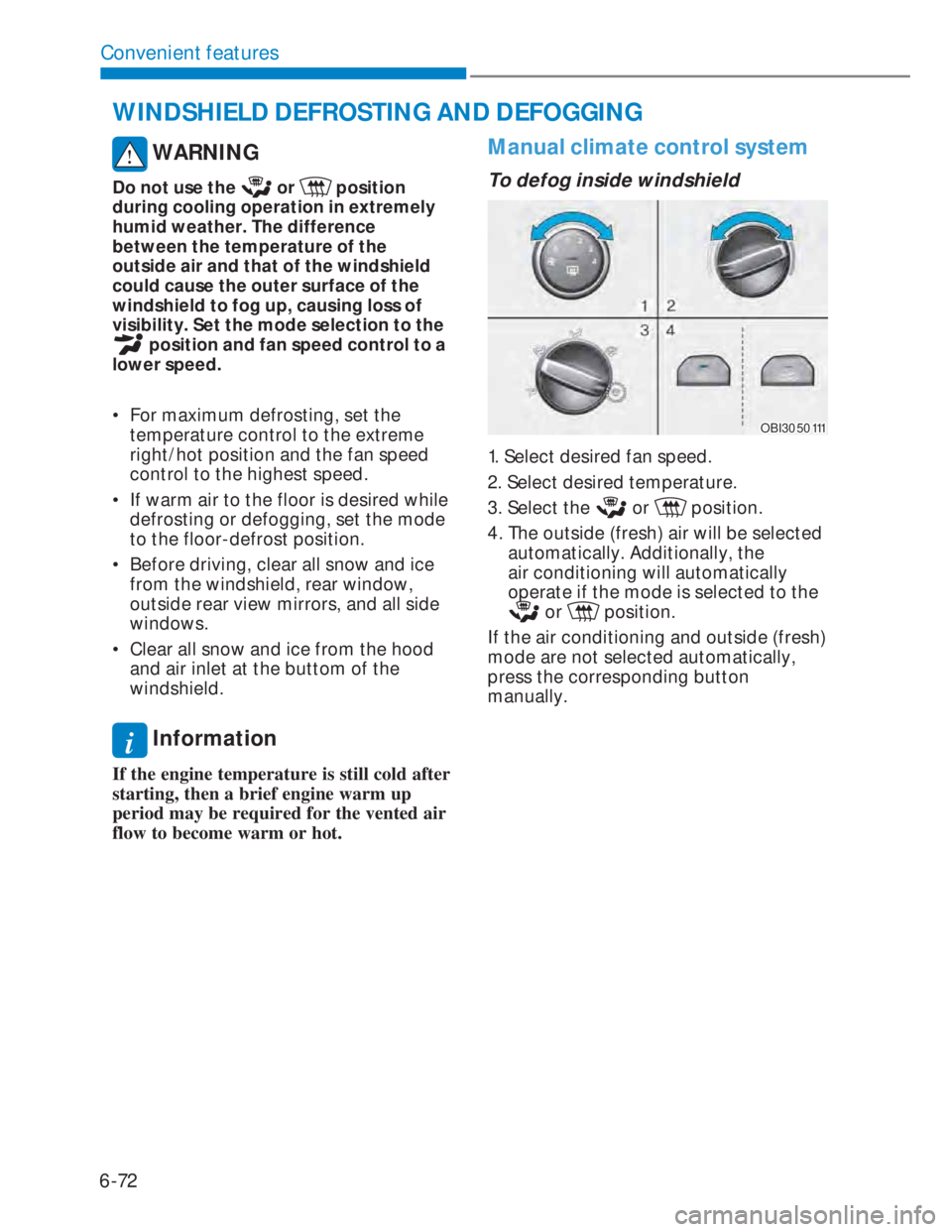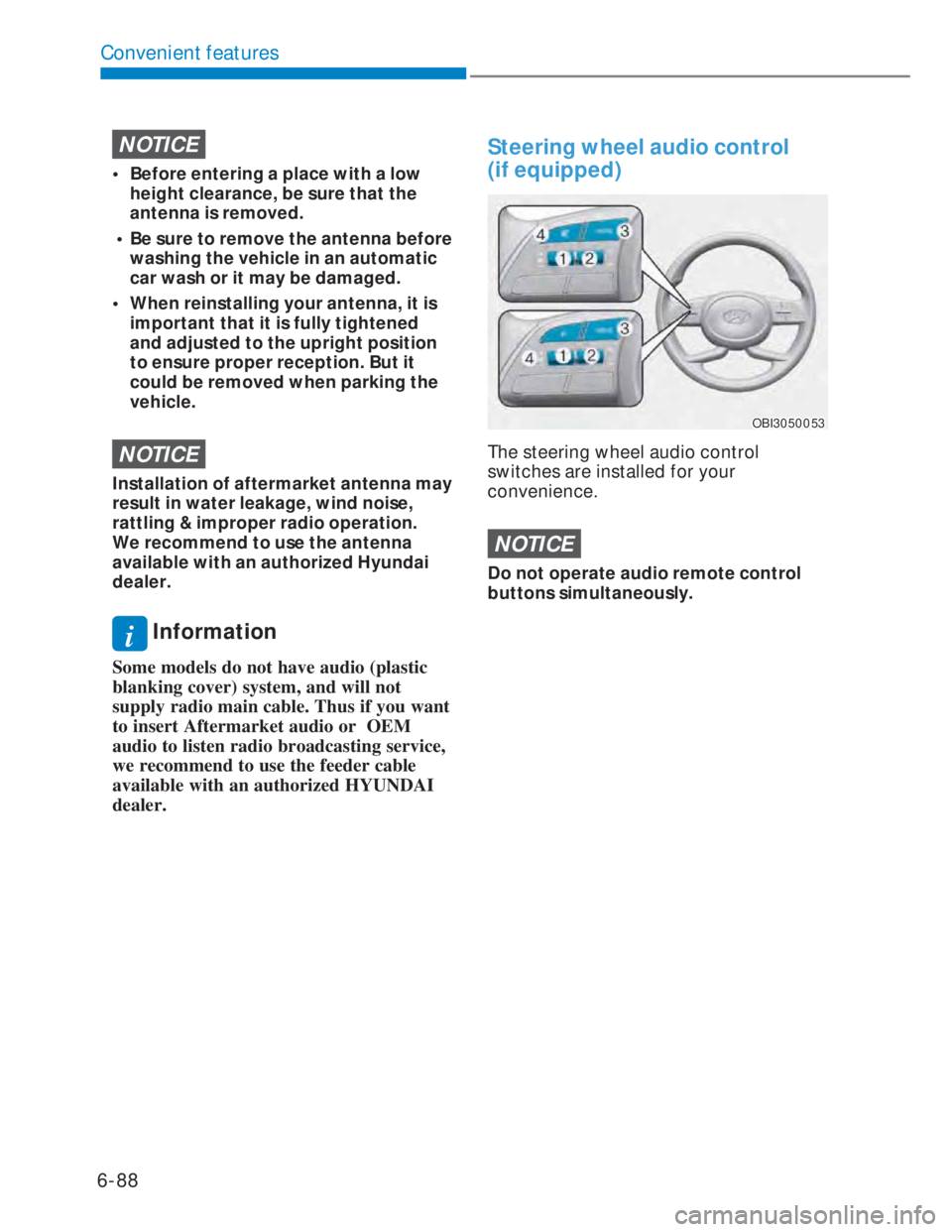2022 HYUNDAI I20 ECO mode
[x] Cancel search: ECO modePage 188 of 444

6-60
Convenient features
Air conditioning system operation tips
• If the vehicle has been parked in direct
sunlight during hot weather, open the
windows for a short time to let the hot
air inside the vehicle escape.
• After sufficient cooling has been
achieved, switch back from
recirculation mode to fresh mode.
• To help reduce moisture inside of
the windows on rainy or humid
days, decrease the humidity inside
the vehicle by operating the air
conditioning system with the windows
and sunroof closed.
• During air conditioning system
operation, you may occasionally
notice a slight change in engine speed
as the air conditioning compressor
cycles. This is a normal system
operation characteristic.
• Use the air conditioning system
every month only for a few minutes
to ensure maximum system
performance.
• When using the air conditioning
system, you may notice clear water
dripping (or even puddling) on the
ground under the passenger side of
the vehicle. This is a normal system
operation characteristic.
• If you operate the air conditioner
excessively, the difference between
the temperature of the outside air and
that of the windshield could cause the
outer surface of the windshield to fog
up, causing loss of visibility. In this
case, set the mode selection button to
the
position and set the fan speed
control knob to the lowest speed
setting.
System maintenance
Climate control air filter
OIK047401LOIK047401L
[A] : Outside air, [B] : Recirculated air
[C] : Climate control air filter, [D] : Blower
[E] : Evaporator core, [F] : Heater core
This filter is installed behind the glove
box. It filters the dust or other pollutants
that enter the vehicle through the
heating and air conditioning system.
We recommend that the climate control
air filter be replaced by an authorized
HYUNDAI dealer according to the
maintenance schedule. If the vehicle is
being driven in severe conditions such
as dusty or rough roads, more frequent
climate control filter inspections and
changes are required.
If the air flow rate suddenly decreases,
we recommend the system be checked
at an authorized HYUNDAI dealer.
i Information
• Replace the filter according to the
Maintenance Schedule.
• If the car is being driven in severe
conditions such as dusty, rough roads,
more frequent climate control air filter
inspections and changes are required.
• When the air flow rate suddenly
decreases, we recommend that the
system be checked by an authorized
HYUNDAI dealer.
Page 194 of 444

6-66
Convenient features
OBI3050103OBI3050103
Instrument panel vents
You can adjust the direction of air
delivered from these vents using the
vent control lever as shown.
Temperature control
OBI3050114OBI3050114
The temperature will increase by
pushing the switch to up.
The temperature will decrease by
pushing the switch to down.
The temperature will increase or
decrease by 0.5°C (1°F) for each
incremental location. When set to the
lowest temperature setting, the air
conditioning will operate continuously.
Temperature conversion
If the battery has been discharged or
disconnected, the temperature mode
display will reset to Centigrade.
To change the temperature unit from °C
to °F or °F to °C :
- Automatic climate control system
Press the AUTO button for 3 seconds
while pressing the OFF button.
- Instrument cluster
Go to User Settings �o Units �o
Temperature Unit.
The temperature unit on both the cluster
LCD display and the climate control
screen will change.
Page 195 of 444

6-67
06
Air intake control
OBI3050108OBI3050108
The air intake control button is used to
select either Fresh mode (outside air) or
Recirculation mode (cabin air).
Recirculated air position
The indicator light on the
button illuminates when
the recirculated air
position is selected.
With the recirculated air
position selected, air from
the passenger
compartment will be
drawn through the climate
control system and heated
or cooled according to the
function selected.
Outside (fresh) air position
The indicator light on the
button will turn off when
the outside (fresh) air
position is selected.
With the outside (fresh) air
position selected, air
enters the vehicle from
outside and is heated or
cooled according to the
function selected.
i Information
Operating the system primarily in Fresh
mode is recommended. Use Recirculation
mode temporarily only when needed.
Prolonged operation of the heater in
Recirculation mode and without the A/C
ON can cause fogging of the windshield.
In addition, prolonged use of the A/C
ON in Recirculation mode may result in
excessively dry, dehumidified air in the
cabin and may promote formation of
musty vent odor due to stagnant air.
WARNING
• Continued use of the climate control
system operation in the recirculated
air position can cause drowsiness
or sleepiness, that may cause loss
of vehicle control resulting in an
accident. Set the air intake control to
the outside (fresh) mode as much as
possible while driving.
• Continued use of the climate
control system operation in the
recirculated air position (without
the air conditioning selected) may
allow humidity to increase inside the
vehicle which may fog the glass and
obscure visibility.
• Do not sleep in a vehicle with air
conditioning or heating system on. It
may cause serious harm or death due
to a drop in the oxygen level and/or
body temperature.
Page 200 of 444

6-72
Convenient features
WARNING
Do not use the or position
during cooling operation in extremely
humid weather. The difference
between the temperature of the
outside air and that of the windshield
could cause the outer surface of the
windshield to fog up, causing loss of
visibility. Set the mode selection to the
position and fan speed control to a
lower speed.
• For maximum defrosting, set the
temperature control to the extreme
right/hot position and the fan speed
control to the highest speed.
• If warm air to the floor is desired while
defrosting or defogging, set the mode
to the floor-defrost position.
• Before driving, clear all snow and ice
from the windshield, rear window,
outside rear view mirrors, and all side
windows.
• Clear all snow and ice from the hood
and air inlet at the buttom of the
windshield.
i Information
If the engine temperature is still cold after
starting, then a brief engine warm up
period may be required for the vented air
flow to become warm or hot.
Manual climate control system
To defog inside windshield
OBI3050111OBI3050111
1. Select desired fan speed.
2. Select desired temperature.
3. Select the
or position.
4. The outside (fresh) air will be selected
automatically. Additionally, the
air conditioning will automatically
operate if the mode is selected to the
or position.
If the air conditioning and outside (fresh)
mode are not selected automatically,
press the corresponding button
manually.
WINDSHIELD DEFROSTING AND DEFOGGING
Page 203 of 444

6-75
06
To cancel or reset the Auto Defogging
System
Press the front windscreen defroster
button for 3 seconds when the ignition
switch is in the ON position.
When the Auto Defogging System is
cancelled, defrost button indicator will
blink 3 times.
When the Auto Defogging System is
reset, defrost button indicator will blink
6 times without a signal.
i Information
When the air conditioning is turned on by
Auto defogging system, if you try to turn
off the air conditioning, the indicator will
blink 3 times and the air conditioning will
not be turned off.
To maintain the effectiveness and
efficiency of the Auto Defogging System,
do not select Recirculation mode whilst
the system is operating.
When the Auto Defogging System is
operating, the blower speed adjustment
knob, the temperature adjustment knob,
and the air intake control button are all
disabled.
NOTICE
Do not remove the sensor cover
located at the top of the driver side
windscreen glass.
Damage to system parts could occur
and may not be covered by your vehicle
warranty.
Defroster
NOTICE
To prevent damage to the conductors
bonded to the inside surface of the rear
window, never use sharp instruments
or window cleaners containing
abrasives to clean the window.
i Information
If you want to defrost and defog the
front windshield, refer to “Windshield
Defrosting and Defogging” in this chapter.
Page 211 of 444

6-83
06
To charge a cellular phone
The wireless cellular phone charging
system charges only the Qi-enabled
cellular phones (
). Read the label on
the cellular phone accessory cover or
visit your cellular phone manufacturer’s
website to check whether your cellular
phone supports the Qi technology.
The wireless charging process starts
when you put a Qi-enabled cellular
phone on the wireless charging unit.
1. Remove other items, including the
smart key, from the wireless charging
unit. If not, the wireless charging
process may be interrupted. Place
the cellular phone on the center of
charging pad.
2. You can turn ON or OFF the wireless
charging function in the User Settings
mode on the instrument cluster. For
further information, refer to the “LCD
Display Modes” in chapter 4.If your cellular phone is not charging:
- Slightly change the position of the
cellular phone on the charging pad.
- Make sure the indicator light is orange.
The ERROR symbol will blink/flash for
10seconds and turn off if there is a
malfunction in the wireless charging
system.
In this case, temporarily stop the
charging process, re-attempt to
wirelessly charge your cellular phone
and then check the charging status
again.
The system warns you with a message
on the LCD display if the cellular phone
is still on the wireless charging unit after
the engine is turned OFF and the front
door is opened.
For some manufacturers’ cellular
phones, the system may not warn you
even though the cellular phone is left on
the wireless charging unit. This is due
to the particular characteristic of the
cellular phone and not a malfunction of
the wireless charging.
CAUTION
To prevent liquid from damaging
the wireless cellular phone charging
system in your vehicle, be sure not to
spill liquid over the pad when charging
your cellular phone.
Page 216 of 444

6-88
Convenient features
NOTICE
• Before entering a place with a low
height clearance, be sure that the
antenna is removed.
• Be sure to remove the antenna before
washing the vehicle in an automatic
car wash or it may be damaged.
• When reinstalling your antenna, it is
important that it is fully tightened
and adjusted to the upright position
to ensure proper reception. But it
could be removed when parking the
vehicle.
NOTICE
Installation of aftermarket antenna may
result in water leakage, wind noise,
rattling & improper radio operation.
We recommend to use the antenna
available with an authorized Hyundai
dealer.
i Information
Some models do not have audio (plastic
blanking cover) system, and will not
supply radio main cable. Thus if you want
to insert Aftermarket audio or OEM
audio to listen radio broadcasting service,
we recommend to use the feeder cable
available with an authorized HYUNDAI
dealer.
Steering wheel audio control
(if equipped)
OBI3050053OBI3050053
The steering wheel audio control
switches are installed for your
convenience.
NOTICE
Do not operate audio remote control
buttons simultaneously.
Page 217 of 444

6-89
06
VOLUME (VOL + / VOL -) (1)
• Move the VOLUME toggle switch up to
increase volume.
• Move the VOLUME toggle switch
down to decrease volume.
SEEK/PRESET ( / ) (2)
If the SEEK/PRESET toggle switch is
moved up or down and held for 0.8
second or more, it will function in the
following modes.
RADIO mode
It will function as the AUTO SEEK select
switch. It will SEEK until you release the
switch.
MEDIA mode
It will function as the FF/REW switch
(except in Bluetooth audio mode).
If the SEEK/PRESET toggle switch is
moved up or down, it will function in the
following modes.
RADIO mode
It will function as the PRESET STATION
UP/DOWN switch.
MEDIA mode
It will function as the TRACK UP/ DOWN
switch.
MODE () (3)
Press the MODE button to select RADIO/
MEDIA/Bluetooth Audio, etc.
MUTE () (4, if equipped)
• Press the button to mute the sound.
• Press the button again to activate the
sound.
• During a call, press to turn off the
microphone.
i Information
Detailed information for audio control
buttons are described in the following
pages in this chapter.
Infotainment system (if equipped)
If your vehicle is equipped with
additional navigation, please refer to the
infotainment system manual separately
supplied.